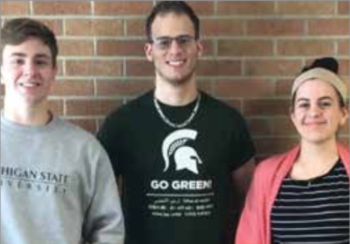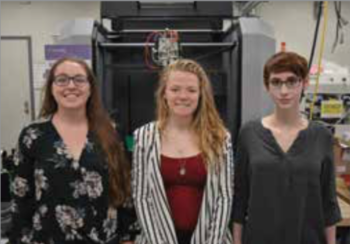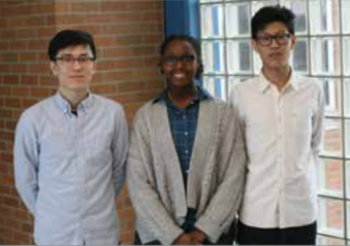Materials Science students participate in Spring Term Design Day. For Spring 2019, the seven teams conducted the following failure analysis investigations:
Get A Grip!: Failure Analysis of INSTRON Tensile Testing Machine Jaw Face
Machines have been helping us understand material analysis for hundreds of years, one of the simplest being a tensile testing machine. This apparatus can apply massive loads to any material, causing it to fail in a way that can then be characterized by engineers. When machines are not used correctly, however, things begin to go wrong. The material failure studied in this project was a jaw face from a tensile testing machine whose top surface broke off in the middle of what should have been a standard tensile test. Through a series of analysis steps, including microscopy (both stereo and SEM), chemical analysis, FEM, and physical characterization, the cause of failure was determined.
A Bad Hinge Date: Failure Analysis of Blum Cabinet Hinge
In the battle of hinge vs. cabinet doors, cabinet doors hold the winning record in the Arabia household. Over the years, several Blum hinges of various models broke under seemingly normal use conditions. A cause of failure was determined through careful examination and imaging of the fracture surfaces via stereomicroscopy and scanning electron microscopy (SEM) in combination with other non-destructive and destructive testing methods. Chemical composition and mechanical properties of the failed hinges were compared to undamaged exemplars to determine processing variability. Exemplars were also examined with similar microscopy techniques to determine their material suitability in this specific hinge application.

The Three Screw-ges: Polymer Extrusion Screw Rod Failure
While attempting to extrude polycarbonate filament, the extrusion screw fractured catastrophically in the metering region. Notably, this piece of equipment was still under warranty. The manufacturing company labeled it as part of a “bad batch,” but the root cause was not determined. The failure surface was visually inspected and documented. Additionally, the screw sent as the warranty replacement was also inspected and documented as an exemplar to evaluate potential differences. Several microstructural cross-sections were obtained along the length of the screw and examined for anomalies. Along with other non-destructive and destructive testing, the team worked to determine the root cause of failure.
Boom Vang Pow: Seldén Rodkicker Rigid Vang Failure Analysis
A Seldén Rodkicker Rigid Vang end fitting of a sailboat was analyzed after it failed due to a sudden and strong gust of wind while out on Lake Erie. The purpose of the device is to aid in sail handling when reefing, as well as to keep the boom from dropping into the cockpit. The failure of the device resulted in the sailboat being unable to sail. The fracture occurred at the end of the part where the vang is attached to the boom by a stainless-steel pin. The exact force exerted on the vang was approximated using historical data of the wind gusts from that day and the surface area of the sail. Destructive testing like chemical composition analysis and non-destructive testing like Scanning Electron Microscopy were used to determine the type and cause of fracture.
F.C.A.P.: PINNACLE Acetabular Hip System Impactor Failure
The PINNACLE® Acetabular Hip System Impactor Assembly from DePuy Synthes has been developed in collaboration with an experienced design team of surgeons. This device, in use, provides a surgeon with general guidance when implanting the PINNACLE® Acetabular Hip System. Three PINNACLE® Straight Impactor Assemblies were obtained, all of which failed in the same manner: the cup impactor end cap broke away from the handle during implantation of the acetabular shell (replacement for the hip). The surgeon was striking the cap with a mallet while performing seating of the shell as it broke. Immediately after failure, both pieces of the device were retrieved, and a replacement impactor of the same type was subsequently installed to complete the surgery. Upon initial investigation of the fracture surfaces, the exact cause of failure was unclear. Further investigation of the fracture surface, assembly design, and manufacturing (through imaging, mechanical testing and analysis, chemical analysis, and microscopy) aided in the determination of what was responsible for the failure.
The Hard Hitters: Framing Hammer Failure Analysis
A claw of a 32-oz heavy-duty claw hammer broke apart on January 14, 2019 while it was being used by a worker from the Christman Construction Company in an on-campus construction site. On this thoroughly rusted hammer, its claw tip and the hammerhead were severely worn. However, there were no traces of brand and product information to be found on this rusty surface. The exact chemistry was unknown, but it would be determined in the following EDS test. Fractographic imaging will help to determine the direction of fracture propagation. Nondestructive test methods like SEM and X-ray spectroscopy along with destructive tests such as hardness tests and fracture toughness will be used to determine possible loading during fracture and the ultimate likely cause of fracture.
Fellowship of the Pin: Analysis of a Differential Cross Pin
An American Axle and Manufacturing Differential Cross Pin was selected for fracture analysis after the pin, which is nickel plated and made of SAE 4320 steel, fractured during routine differential fatigue testing. It is hypothesized that the part experienced bending and shear stresses from improper gear interaction during fatigue testing. The failure surface was examined via optical microscopy and scanning electron microscopy. Through destructive and non-destructive testing, the sample’s integrity will be investigated to identify the failure cause and initiation site.






